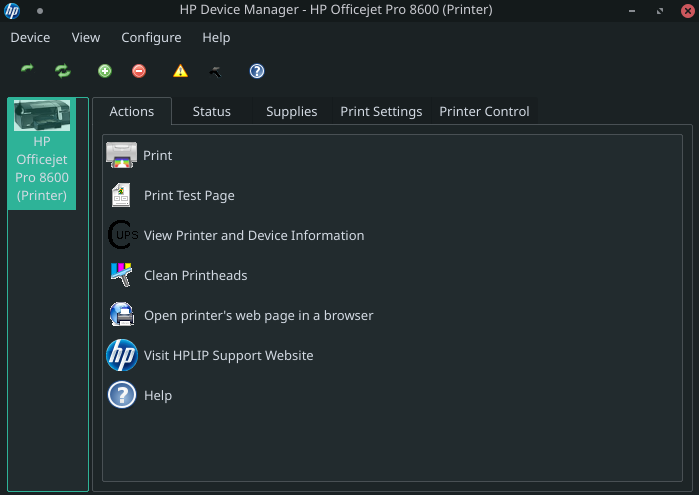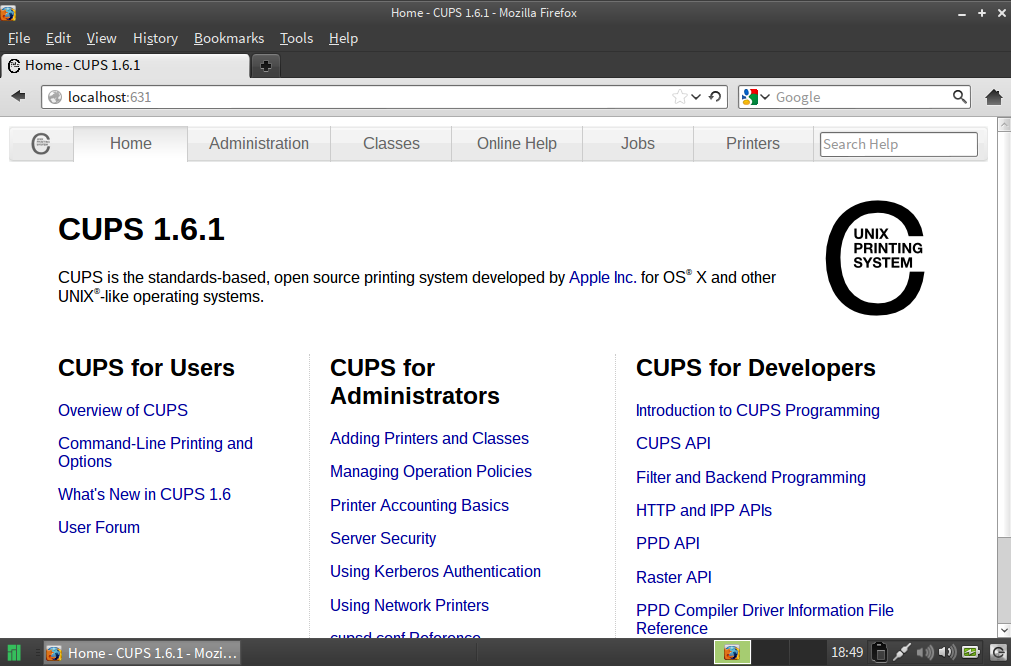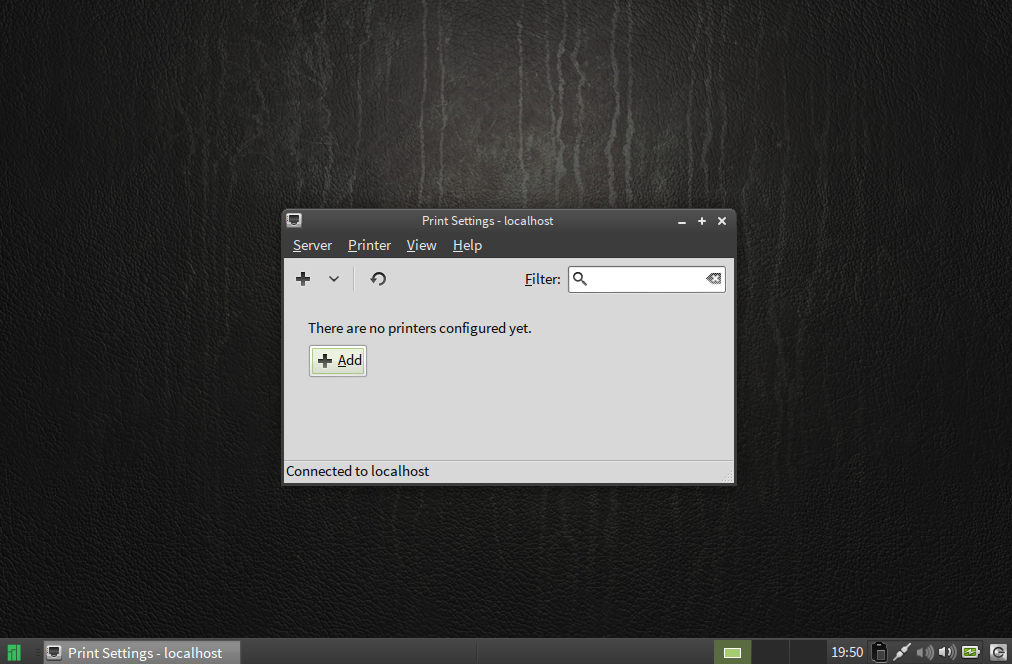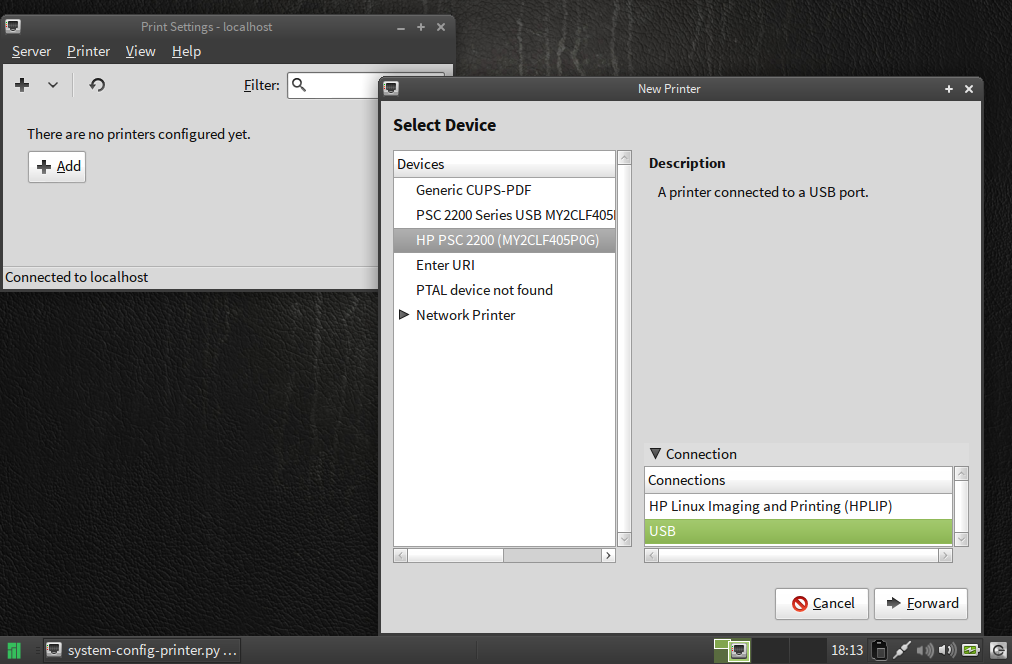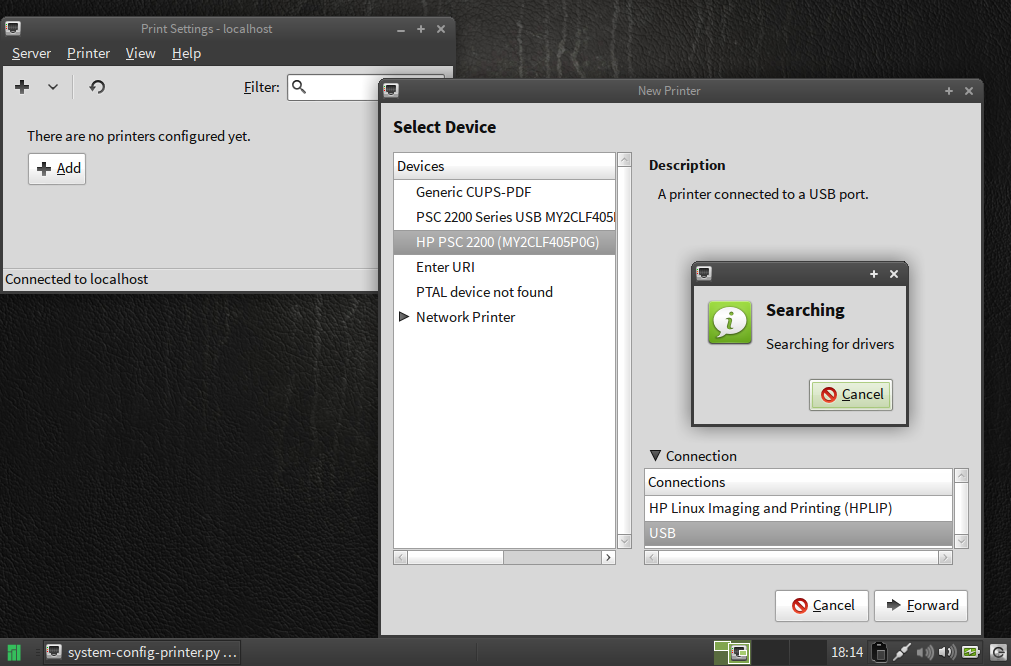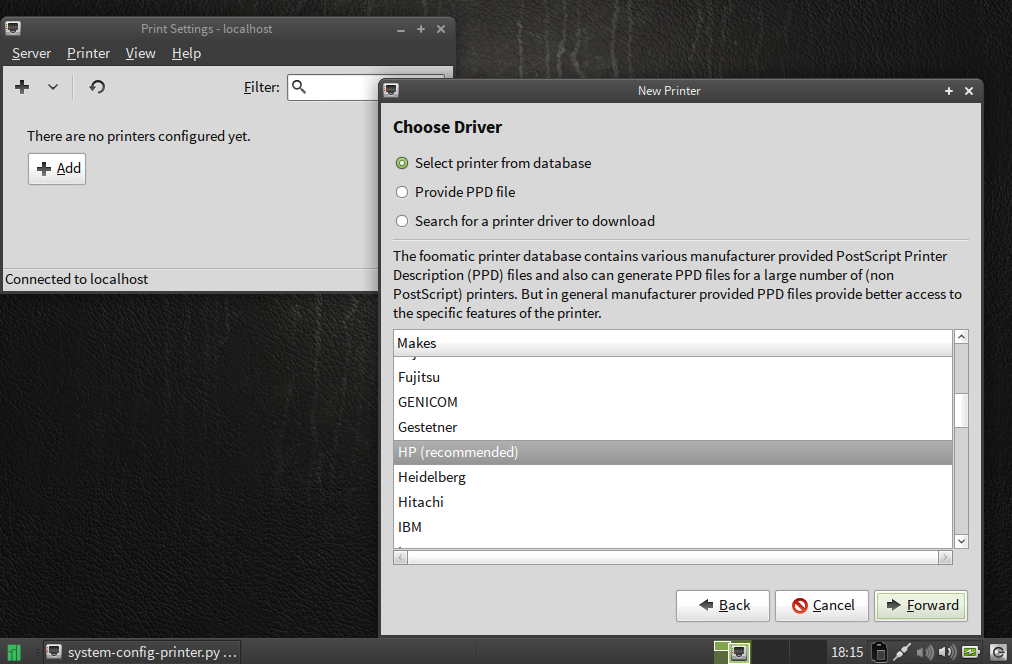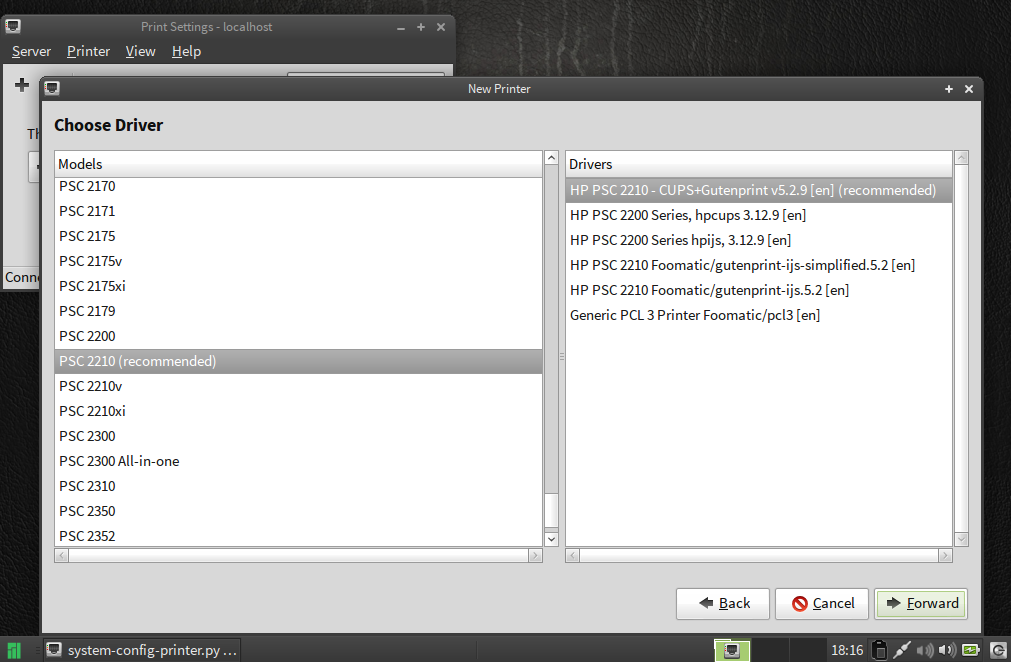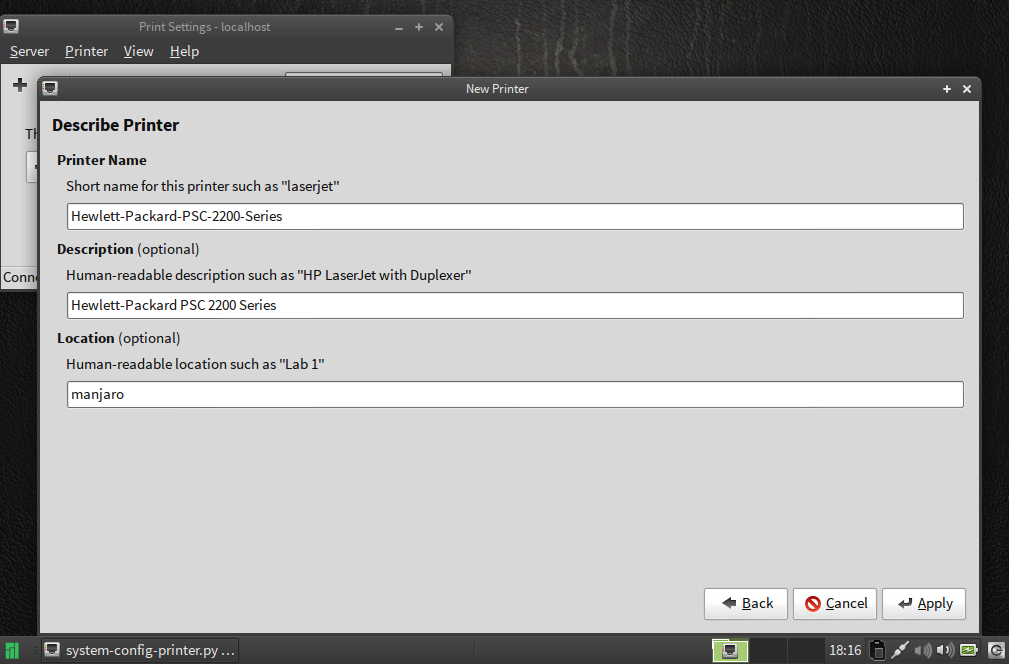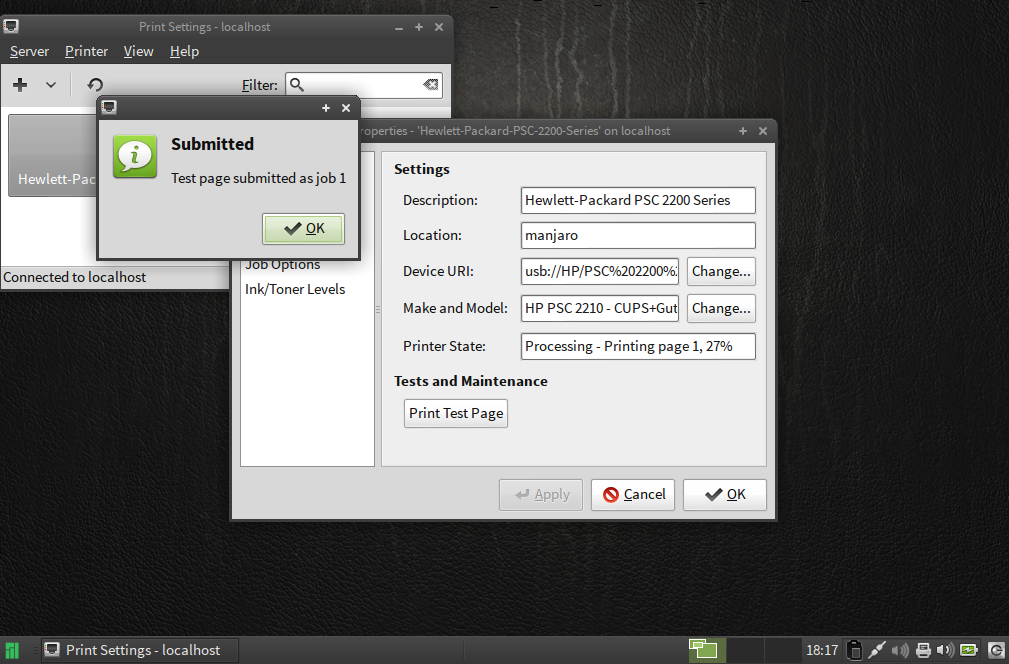Difference between revisions of "Printing"
Views
Actions
Namespaces
Variants
Tools
imported>Dalto m (Dalto moved page Printer Configuration to Printing: Merging two printing articles into one) |
(Rewrite hplip-plugin section with various corrections) |
||
| (37 intermediate revisions by 16 users not shown) | |||
| Line 1: | Line 1: | ||
<languages/> | |||
__TOC__ | |||
<translate> | |||
= Overview = <!--T:1--> | |||
<!--T:2--> | |||
Printing is undertaken through the use of [http://en.wikipedia.org/wiki/CUPS CUPS] (previously an acronym for '''C'''ommon '''U'''nix '''P'''rinting '''S'''ystem). This is a popular open source printing system used in most Linux distributions due to its ease of use. | |||
= Installing the Printer Software = <!--T:3--> | |||
= | <!--T:4--> | ||
First, install the {{ic|manjaro-printer}} package using your favorite package manager or by using the command: | |||
{{UserCmd|command=pamac install manjaro-printer}} | |||
<!--T:5--> | |||
Note that you may need to add yourself to the {{ic|sys}} group. To do this, use the command: | |||
{{UserCmd|command=sudo gpasswd -a your_username sys}} | |||
<!--T:65--> | |||
Some HP printers require proprietary software technologies to allow full access to printer features and performance. Unfortunately, these technologies cannot be open sourced by HP. To resolve this, HP uses a binary plugin for these printers. | |||
This does not come preinstalled with Manjaro as the license prohibits redistributing it. However an [[Arch_User_Repository|AUR]] package is available. | |||
{{UserCmd|command=pamac build hplip-plugin}} | |||
<!--T:66--> | |||
For a list of affected HP printers, please see the [https://developers.hp.com/hp-linux-imaging-and-printing/binary_plugin.html HP developers page]. | |||
= Enabling Printing Capabilities = <!--T:6--> | |||
<!--T:7--> | |||
Once the necessary software has been installed, to start and enable printing capabilities, enter the following commands: | |||
{{UserCmd|command=sudo systemctl enable --now cups.service}} | |||
{{UserCmd|command=sudo systemctl enable --now cups.socket}} | |||
{{UserCmd|command=sudo systemctl enable --now cups.path}} | |||
<!--T:62--> | |||
If easy detection of network printers is needed (not all editions have avahi installed and running) the following service can be installed & started: | |||
<!--T:63--> | |||
{{UserCmd|command=pamac install avahi}} | |||
{{UserCmd|command=sudo systemctl enable --now avahi-daemon.service}} | |||
<!--T:8--> | |||
At this point you should be ready to configure a printer | |||
=Managing Printers= <!--T:9--> | |||
==Managing Printers with HP Device Manager== <!--T:10--> | |||
[[File:Hplip.png|left|375px]] | |||
<!--T:11--> | |||
If have a printer made by HP, the easiest way to manage it is with the HP Device Manager({{ic|hp-toolbox}}). It is wizard based and handles automatic detection and setup of your printer locally or across a network. | |||
<!--T:12--> | |||
You can run it by selecting '''HP Device Manager''' from the menu or with the command {{ic|hp-toolbox}}. | |||
<!--T:13--> | |||
<br clear="all" /> | |||
==Managing Printers with CUPS== <!--T:14--> | |||
<!--T:15--> | |||
Another way to add a printer is to use CUPS directly. Assuming CUPS has been enabled (and started), upon connecting a printer, it should be automatically detected and configured for you to use. The process itself should take only about a minute. However, if the automatic detection and configuration doesn't seem to work, then your printer can be manually set up with relative ease. There are two methods to do so: | |||
<!--T:16--> | |||
* '''Webpage Interface''': CUPS provides an webpage interface that will open in your default web browser to configure your printer. This interface also provides access to further information about CUPS, as well as on-line help. | |||
<!--T:17--> | |||
* '''Desktop Interface''': A standard desktop wizard is also available, which should be instantly familiar to those who have configured a printer before, whether using Linux or another operating system such as windows. Note that you may need to install your DE's printer config package using your favorite package manager or by using one of the following commands. | |||
GNOME: | |||
{{UserCmd|command=pamac install system-config-printer}} | |||
KDE: | |||
{{UserCmd|command=pamac install print-manager}} | |||
===CUPS Webpage Interface=== <!--T:18--> | |||
<!--T:19--> | |||
[[File:CUPSweb.png|thumb|left|375px]] | [[File:CUPSweb.png|thumb|left|375px]] | ||
<!--T:20--> | |||
To access the webpage interface, select '''Manage Printing''' from your desktop menu. The interface will automatically open in your default web browser. Alternatively, you can also open your choice of web browser, and enter the following into the address bar: | To access the webpage interface, select '''Manage Printing''' from your desktop menu. The interface will automatically open in your default web browser. Alternatively, you can also open your choice of web browser, and enter the following into the address bar: | ||
http://localhost:631/ | <!--T:21--> | ||
http://localhost:631/ | |||
{{ | <!--T:22--> | ||
{{BoxSuccess|Tip|You can also just click the address provided above to access the CUPS web interface!}} | |||
<br clear="all" /> | <br clear="all" /> | ||
== CUPS Desktop Interface Part 1: The Automatic Method == | ===CUPS Desktop Interface Part 1: The Automatic Method=== <!--T:23--> | ||
<!--T:24--> | |||
[[File:CUPS1.png|thumb|left|375px]] | [[File:CUPS1.png|thumb|left|375px]] | ||
<!--T:25--> | |||
'''1. Add your printer'''. Ensuring that your printer is properly connected and switched on, select '''Print Settings''' from your desktop menu. Once the ''Print Settings'' window has opened, click '''+ add''' to add a new printer. | '''1. Add your printer'''. Ensuring that your printer is properly connected and switched on, select '''Print Settings''' from your desktop menu. Once the ''Print Settings'' window has opened, click '''+ add''' to add a new printer. | ||
<br clear="all" /> | <br clear="all" /> | ||
<!--T:26--> | |||
[[File:CUPS2.png|thumb|left|375px]] | [[File:CUPS2.png|thumb|left|375px]] | ||
<!--T:27--> | |||
'''2. Select your printer name'''. Once the ''New Printer'' window has opened, under the '''Select Device''' heading, find the name of your printer and click to highlight it. If your printer is listed more than once, check the description on the right to ensure your selection is not for another function, such as scanning or faxing. | '''2. Select your printer name'''. Once the ''New Printer'' window has opened, under the '''Select Device''' heading, find the name of your printer and click to highlight it. If your printer is listed more than once, check the description on the right to ensure your selection is not for another function, such as scanning or faxing. | ||
<!--T:28--> | |||
'''3. Select your printer connection'''. Under the '''Connection''' heading, click to highlight your printer's connection method. As illustrated, this will usually always be 'USB'. | '''3. Select your printer connection'''. Under the '''Connection''' heading, click to highlight your printer's connection method. As illustrated, this will usually always be 'USB'. | ||
<br clear="all" /> | <br clear="all" /> | ||
<!--T:29--> | |||
[[File:CUPS3.png|thumb|left|375px]] | [[File:CUPS3.png|thumb|left|375px]] | ||
<!--T:30--> | |||
'''4. Install your printer driver'''. Once your printer name and connection have been highlighted, click the '''Forward''' button and CUPS will automatically search for the available drivers for it. In most instances, once the appropriate driver has been found it will be automatically installed, and the set-up process will have completed. | '''4. Install your printer driver'''. Once your printer name and connection have been highlighted, click the '''Forward''' button and CUPS will automatically search for the available drivers for it. In most instances, once the appropriate driver has been found it will be automatically installed, and the set-up process will have completed. | ||
<!--T:31--> | |||
Otherwise, if the process did not succeed, it will be necessary to click the forward button again in order chose the appropriate driver yourself. | Otherwise, if the process did not succeed, it will be necessary to click the forward button again in order chose the appropriate driver yourself. | ||
<br clear="all" /> | <br clear="all" /> | ||
== CUPS Desktop Interface Part 2: The Manual Method == | ===CUPS Desktop Interface Part 2: The Manual Method=== <!--T:32--> | ||
<!--T:33--> | |||
[[File:CUPS4.png|thumb|left|375px]] | [[File:CUPS4.png|thumb|left|375px]] | ||
{{ | <!--T:34--> | ||
{{BoxSuccess|Tip|CUPS will usually help you out by showing recommended choices for each step.}} | |||
<!--T:35--> | |||
'''1. Select your printer make'''. If the Automatic method did not automatically find and install an appropriate driver for your printer, then clicking the forward button again will present the ''Chose Driver'' window. The first step is to select the make of your printer. As illustrated, as an HP printer is to be installed, the recommended choice of ''HP'' has been highlighted by clicking on it. | '''1. Select your printer make'''. If the Automatic method did not automatically find and install an appropriate driver for your printer, then clicking the forward button again will present the ''Chose Driver'' window. The first step is to select the make of your printer. As illustrated, as an HP printer is to be installed, the recommended choice of ''HP'' has been highlighted by clicking on it. | ||
<!--T:36--> | |||
Once your make of printer has been highlighted, click the forward button to proceed to the next step. | Once your make of printer has been highlighted, click the forward button to proceed to the next step. | ||
<br clear="all" /> | <br clear="all" /> | ||
<!--T:37--> | |||
[[File:CUPS5.png|thumb|left|375px]] | [[File:CUPS5.png|thumb|left|375px]] | ||
<!--T:38--> | |||
'''2. Select your printer model'''. Under the left-heading '''models''', select the specific model of your printer. As illustrated, as the printer model to be installed in this instance is a Model 2210, the recommended choice of ''PSC 2210'' has been highlighted by clicking on it. | '''2. Select your printer model'''. Under the left-heading '''models''', select the specific model of your printer. As illustrated, as the printer model to be installed in this instance is a Model 2210, the recommended choice of ''PSC 2210'' has been highlighted by clicking on it. | ||
<!--T:39--> | |||
'''3. Select your printer driver'''. At last! Under the right-heading '''Drivers''', select the appropriate driver for your printer. As illustrated, the recommended printer driver has been clicked to highlight it. '''It is advised that you also select whatever driver is recommended for you'''. | '''3. Select your printer driver'''. At last! Under the right-heading '''Drivers''', select the appropriate driver for your printer. As illustrated, the recommended printer driver has been clicked to highlight it. '''It is advised that you also select whatever driver is recommended for you'''. | ||
<!--T:40--> | |||
Once your printer model and driver have been highlighted, click the forward button to proceed to the next step. | Once your printer model and driver have been highlighted, click the forward button to proceed to the next step. | ||
<br clear="all" /> | <br clear="all" /> | ||
<!--T:41--> | |||
[[File:CUPS6.png|thumb|left|375px]] | [[File:CUPS6.png|thumb|left|375px]] | ||
<!--T:42--> | |||
'''4. Choose your printer name, description (optional), and location (optional)'''. Unless you want to change something, it will not be necessary to make any amendments here. | '''4. Choose your printer name, description (optional), and location (optional)'''. Unless you want to change something, it will not be necessary to make any amendments here. | ||
<!--T:43--> | |||
If you are happy with the information provided - or have made the desired changes - click the '''Apply''' button to complete the process. | If you are happy with the information provided - or have made the desired changes - click the '''Apply''' button to complete the process. | ||
<br clear="all" /> | <br clear="all" /> | ||
<!--T:44--> | |||
[[File:CUPS7.png|thumb|left|375px]] | [[File:CUPS7.png|thumb|left|375px]] | ||
<!--T:45--> | |||
'''5. Configure your printer'''. Having clicked the Apply button in the previous step, your printer's properties will be displayed. By selecting the categories on the right-hand side, you can view information and amend your printer's settings if you wish. '''The standard settings will be fine for most people, so unless you have something specific in mind, there will be nothing you need to do'''. | '''5. Configure your printer'''. Having clicked the Apply button in the previous step, your printer's properties will be displayed. By selecting the categories on the right-hand side, you can view information and amend your printer's settings if you wish. '''The standard settings will be fine for most people, so unless you have something specific in mind, there will be nothing you need to do'''. | ||
<!--T:46--> | |||
'''6. Test your printer'''. Although optional, this step is highly recommended! Click the '''Print Test Page''' button to ensure that your printer is set up and working properly. | '''6. Test your printer'''. Although optional, this step is highly recommended! Click the '''Print Test Page''' button to ensure that your printer is set up and working properly. | ||
{{ | <!--T:47--> | ||
{{BoxSuccess|Tip|Your printer properties can be accessed - and changed - at any time by selecting the '''Print Settings''' option from your menu, and then double-clicking your printer's icon.}} | |||
<!--T:48--> | |||
That's it! Now click the '''OK''' button to close the window and start using your printer. | That's it! Now click the '''OK''' button to close the window and start using your printer. | ||
<br clear="all" /> | <br clear="all" /> | ||
===Modifying an Installed Printer=== <!--T:49--> | |||
<!--T:50--> | |||
To configure an installed printer at any time: | To configure an installed printer at any time: | ||
<!--T:51--> | |||
'''1.''' select the '''Print Settings''' option from your desktop menu, and | '''1.''' select the '''Print Settings''' option from your desktop menu, and | ||
<!--T:52--> | |||
'''2.''' double-click the printer's icon. | '''2.''' double-click the printer's icon. | ||
<!--T:53--> | |||
The configuration window will appear. Select any of the categories on the left-hand side of the window to view the appropriate information and make any desired changes. Once complete, click the '''Apply''' and then '''OK''' buttons to confirm and save your changes, or click the '''Cancel''' button to close the window without making any changes. | The configuration window will appear. Select any of the categories on the left-hand side of the window to view the appropriate information and make any desired changes. Once complete, click the '''Apply''' and then '''OK''' buttons to confirm and save your changes, or click the '''Cancel''' button to close the window without making any changes. | ||
= Removing an Installed Printer = | ===Removing an Installed Printer=== <!--T:54--> | ||
<!--T:55--> | |||
If for any reason you wish to remove a printer (e.g. to reinstall it), select the '''Print Settings''' option from your menu, right-click your printer's icon, and then select '''delete'''. You will need to confirm your decision to delete the printer, as well as enter your password to complete the task. | If for any reason you wish to remove a printer (e.g. to reinstall it), select the '''Print Settings''' option from your menu, right-click your printer's icon, and then select '''delete'''. You will need to confirm your decision to delete the printer, as well as enter your password to complete the task. | ||
= Disabling Printing Capabilities = <!--T:56--> | |||
<!--T:57--> | |||
If for any reason you wish to disable CUPS (e.g. in order to use an alternative printing system), open your terminal and enter the following command: | |||
{{UserCmd|command=sudo systemctl disable --now cups.service}} | |||
{{UserCmd|command=sudo systemctl disable --now cups.socket}} | |||
{{UserCmd|command=sudo systemctl disable --now cups.path}} | |||
= Specific printers/scanners that are known to work = <!--T:58--> | |||
<!--T:59--> | |||
{| class="wikitable" | |||
|- | |||
! Brand !! Type !! Print !! Scan !! Description how to set up !! Issues & Solutions !! More info !! | |||
|- | |||
| Canon || mp 280 || Yes, via network|| Yes, only local || CUPS and manjaro-printer || Remote scanning | |||
|- | |||
| Canon || Pixma MX535 || Yes, via network|| Yes, via network || Manjaro printer detects remote printer as mx530. scanner needs scangearmp2-sane-git to function properly || Needs avahi and in my case ipv6 for some reason to be able to 'see' the printer (@hanzel on the forum) | |||
|- | |||
| Canon || PIXMA TR4522 || || || Needs: cnijfilter2 or cnijfilter2-bin from the [[Arch_User_Repository|AUR]] || || [https://forum.manjaro.org/t/installing-a-canon-pixma-tr4522/78221 forum post] | |||
|- | |||
| Canon || PIXMA TS5120 || Yes|| Yes || Scanner seems to work after CUPS and manjaro-printer, printing requires cnijfilter and selecting Canon TS5100 series drivers|| Needs: cnijfilter2 or cnijfilter2-bin from the [[Arch_User_Repository|AUR]] || || | |||
|- | |||
| Canon || Pixma Pro-100 || Yes, via network and local || Not a feature || manjaro-printer || Takes a moment to start printing, just be patient | |||
|- | |||
| Canon || ISensys || LBP223dw || Yes || || || [https://forum.manjaro.org/t/installation-canon-i-sensys-lbp223dw/80306 forum post] | |||
|- | |||
| Canon || Pixma E4270 || Yes via Network || not tested || Needs: cnijfilter2 or cnijfilter2-bin from the [[Arch_User_Repository|AUR]] || || [https://forum.manjaro.org/t/canon-pixma-e4270/86212 forum post] | |||
|- | |||
| Canon || Pixma G2100 || Yes || Yes || Plug& play || || [https://forum.manjaro.org/t/does-canon-printers-well-supported/87040/5 forum post] | |||
|- | |||
| Canon || PIXMA MG3650 || || Yes || || || [https://forum.manjaro.org/t/troubles-with-printing-on-canon-pixma-mg3650/136112/1 forum post] | |||
<!--T:64--> | |||
|- | |||
| Epson || ET-M1120 || Yes, via Network || Not a feature || manjaro-printer and system-config-printer || Needs: epson-inkjet-printer-escpr and epson-inkjet-printer-escpr2 in [[Arch_User_Repository|AUR]] and then patch from pacman | |||
|- | |||
| Epson|| WF-3825 driver || || || Needs: epson-inkjet-printer-escpr2 [[Arch_User_Repository|AUR]] || || [https://forum.manjaro.org/t/epson-wf-3825-driver/77910/5 Forum post] | |||
<!--T:61--> | |||
|} | |||
<!--T:60--> | |||
Table made from suggestion [https://forum.manjaro.org/t/printer-overview-and-functionality-on-manjaro/79794 here] | |||
</translate> | |||
[[Category:Contents Page]] | [[Category:Contents Page{{#translation:}}]] | ||
Latest revision as of 16:14, 27 August 2024
Overview
Printing is undertaken through the use of CUPS (previously an acronym for Common Unix Printing System). This is a popular open source printing system used in most Linux distributions due to its ease of use.
Installing the Printer Software
First, install the manjaro-printer package using your favorite package manager or by using the command:
Note that you may need to add yourself to the sys group. To do this, use the command:
Some HP printers require proprietary software technologies to allow full access to printer features and performance. Unfortunately, these technologies cannot be open sourced by HP. To resolve this, HP uses a binary plugin for these printers. This does not come preinstalled with Manjaro as the license prohibits redistributing it. However an AUR package is available.
For a list of affected HP printers, please see the HP developers page.
Enabling Printing Capabilities
Once the necessary software has been installed, to start and enable printing capabilities, enter the following commands:
If easy detection of network printers is needed (not all editions have avahi installed and running) the following service can be installed & started:
At this point you should be ready to configure a printer
Managing Printers
Managing Printers with HP Device Manager
If have a printer made by HP, the easiest way to manage it is with the HP Device Manager(hp-toolbox). It is wizard based and handles automatic detection and setup of your printer locally or across a network.
You can run it by selecting HP Device Manager from the menu or with the command hp-toolbox.
Managing Printers with CUPS
Another way to add a printer is to use CUPS directly. Assuming CUPS has been enabled (and started), upon connecting a printer, it should be automatically detected and configured for you to use. The process itself should take only about a minute. However, if the automatic detection and configuration doesn't seem to work, then your printer can be manually set up with relative ease. There are two methods to do so:
- Webpage Interface: CUPS provides an webpage interface that will open in your default web browser to configure your printer. This interface also provides access to further information about CUPS, as well as on-line help.
- Desktop Interface: A standard desktop wizard is also available, which should be instantly familiar to those who have configured a printer before, whether using Linux or another operating system such as windows. Note that you may need to install your DE's printer config package using your favorite package manager or by using one of the following commands.
GNOME:
KDE:
CUPS Webpage Interface
To access the webpage interface, select Manage Printing from your desktop menu. The interface will automatically open in your default web browser. Alternatively, you can also open your choice of web browser, and enter the following into the address bar:
http://localhost:631/
CUPS Desktop Interface Part 1: The Automatic Method
1. Add your printer. Ensuring that your printer is properly connected and switched on, select Print Settings from your desktop menu. Once the Print Settings window has opened, click + add to add a new printer.
2. Select your printer name. Once the New Printer window has opened, under the Select Device heading, find the name of your printer and click to highlight it. If your printer is listed more than once, check the description on the right to ensure your selection is not for another function, such as scanning or faxing.
3. Select your printer connection. Under the Connection heading, click to highlight your printer's connection method. As illustrated, this will usually always be 'USB'.
4. Install your printer driver. Once your printer name and connection have been highlighted, click the Forward button and CUPS will automatically search for the available drivers for it. In most instances, once the appropriate driver has been found it will be automatically installed, and the set-up process will have completed.
Otherwise, if the process did not succeed, it will be necessary to click the forward button again in order chose the appropriate driver yourself.
CUPS Desktop Interface Part 2: The Manual Method
1. Select your printer make. If the Automatic method did not automatically find and install an appropriate driver for your printer, then clicking the forward button again will present the Chose Driver window. The first step is to select the make of your printer. As illustrated, as an HP printer is to be installed, the recommended choice of HP has been highlighted by clicking on it.
Once your make of printer has been highlighted, click the forward button to proceed to the next step.
2. Select your printer model. Under the left-heading models, select the specific model of your printer. As illustrated, as the printer model to be installed in this instance is a Model 2210, the recommended choice of PSC 2210 has been highlighted by clicking on it.
3. Select your printer driver. At last! Under the right-heading Drivers, select the appropriate driver for your printer. As illustrated, the recommended printer driver has been clicked to highlight it. It is advised that you also select whatever driver is recommended for you.
Once your printer model and driver have been highlighted, click the forward button to proceed to the next step.
4. Choose your printer name, description (optional), and location (optional). Unless you want to change something, it will not be necessary to make any amendments here.
If you are happy with the information provided - or have made the desired changes - click the Apply button to complete the process.
5. Configure your printer. Having clicked the Apply button in the previous step, your printer's properties will be displayed. By selecting the categories on the right-hand side, you can view information and amend your printer's settings if you wish. The standard settings will be fine for most people, so unless you have something specific in mind, there will be nothing you need to do.
6. Test your printer. Although optional, this step is highly recommended! Click the Print Test Page button to ensure that your printer is set up and working properly.
That's it! Now click the OK button to close the window and start using your printer.
Modifying an Installed Printer
To configure an installed printer at any time:
1. select the Print Settings option from your desktop menu, and
2. double-click the printer's icon.
The configuration window will appear. Select any of the categories on the left-hand side of the window to view the appropriate information and make any desired changes. Once complete, click the Apply and then OK buttons to confirm and save your changes, or click the Cancel button to close the window without making any changes.
Removing an Installed Printer
If for any reason you wish to remove a printer (e.g. to reinstall it), select the Print Settings option from your menu, right-click your printer's icon, and then select delete. You will need to confirm your decision to delete the printer, as well as enter your password to complete the task.
Disabling Printing Capabilities
If for any reason you wish to disable CUPS (e.g. in order to use an alternative printing system), open your terminal and enter the following command:
Specific printers/scanners that are known to work
| Brand | Type | Scan | Description how to set up | Issues & Solutions | More info | ||
|---|---|---|---|---|---|---|---|
| Canon | mp 280 | Yes, via network | Yes, only local | CUPS and manjaro-printer | Remote scanning | ||
| Canon | Pixma MX535 | Yes, via network | Yes, via network | Manjaro printer detects remote printer as mx530. scanner needs scangearmp2-sane-git to function properly | Needs avahi and in my case ipv6 for some reason to be able to 'see' the printer (@hanzel on the forum) | ||
| Canon | PIXMA TR4522 | Needs: cnijfilter2 or cnijfilter2-bin from the AUR | forum post | ||||
| Canon | PIXMA TS5120 | Yes | Yes | Scanner seems to work after CUPS and manjaro-printer, printing requires cnijfilter and selecting Canon TS5100 series drivers | Needs: cnijfilter2 or cnijfilter2-bin from the AUR | ||
| Canon | Pixma Pro-100 | Yes, via network and local | Not a feature | manjaro-printer | Takes a moment to start printing, just be patient | ||
| Canon | ISensys | LBP223dw | Yes | forum post | |||
| Canon | Pixma E4270 | Yes via Network | not tested | Needs: cnijfilter2 or cnijfilter2-bin from the AUR | forum post | ||
| Canon | Pixma G2100 | Yes | Yes | Plug& play | forum post | ||
| Canon | PIXMA MG3650 | Yes | forum post | ||||
| Epson | ET-M1120 | Yes, via Network | Not a feature | manjaro-printer and system-config-printer | Needs: epson-inkjet-printer-escpr and epson-inkjet-printer-escpr2 in AUR and then patch from pacman | ||
| Epson | WF-3825 driver | Needs: epson-inkjet-printer-escpr2 AUR | Forum post |
Table made from suggestion here
